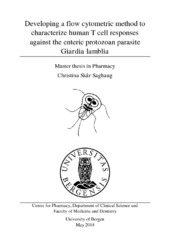| dc.description.abstract | Giardia lamblia is an enteric protozoan parasite, which causes infection in humans worldwide. The impact of the infection varies from asymptomatic carriers to severe disease such as malabsorption syndrome. Evidence for acquired immunity against Giardia infection has been found in previous studies. CD4+ T cell responses have been detected in humans, but data regarding cytokine producing profiles of these T cells is limited. This study aimed to develop a flow cytometric method to investigate Giardia-specific CD4+ T cell responses in individuals with recent giardiasis. Early cytokine profiles in addition to later surface markers and proliferation were combined to explore Giardia-specific CD4+ T cell immune responses by flow cytometry. In the development of the flow cytometric assay, fluorochrome-conjugated antibodies were titrated and different clones tested, detector voltages on the flow cytometer were adjusted, CellTrace proliferation dye labeling method and concentration was optimized, spectral overlap was minimized, compensation matrices were acquired and different fixation and permeabilization reagents were tested. To explore the function of the assay, cultures of peripheral blood mononuclear cells (PBMCs) from a group of individuals with recent giardiasis were stimulated with Giardia assemblage A and B sonicated soluble proteins (SSA and SSB), and responses were compared to responses in PBMCs from a group of low risk healthy controls. Early cytokine profiles in addition to later surface markers and proliferation were compared between these groups to explore Giardia-specific CD4+ T cell immune responses by flow cytometry. The first assay (day one assay) investigated cytokine expression of TNA-α, IFN-γ, IL-17A, IL-10 and IL-4 in effector memory CD4+ T cells (CD197-CD45RA-) after 24 hours of stimulation with Giardia soluble proteins and controls antigens. The other assay (day six assay) investigated proliferation by CellTrace dye dilution and activation markers HLA- DR, CD45RO, CD25 and CD26 after six days of stimulation. The results were analyzed in FlowJo, and statistical analysis was done using SPSS. Cytokine responses were stronger in the Giardia exposed group when stimulated with SSA and SSB, but only IL-17A production was found to be significantly elevated in this group. Two participants with current, on-going, giardiasis had markedly elevated production of all cytokines, except IL-4, in response to SSA and SSB, but not to control antigens. In the day six assay CD45RO and HLA-DR positive cell percentages were found to be significantly different between the groups when stimulated with SSA. A positive correlation between SSA and SSB induced effector memory CD4+ T cell cytokine production, as well as proliferation responses was found, indicating considerable cross-reaction between these two assemblages. In conclusion, we find that the developed assay performed well and can be used to assess Giardia-specific immunity, but it has some shortcomings. Although the assay showed generally higher responses in the giardiasis exposed group for most of the outcomes, only IL-17A production, and HLADR+CD45RO+ activation turned out to be statistically significant. Future studies using purified recombinant Giardia proteins as antigens may... | en_US |
